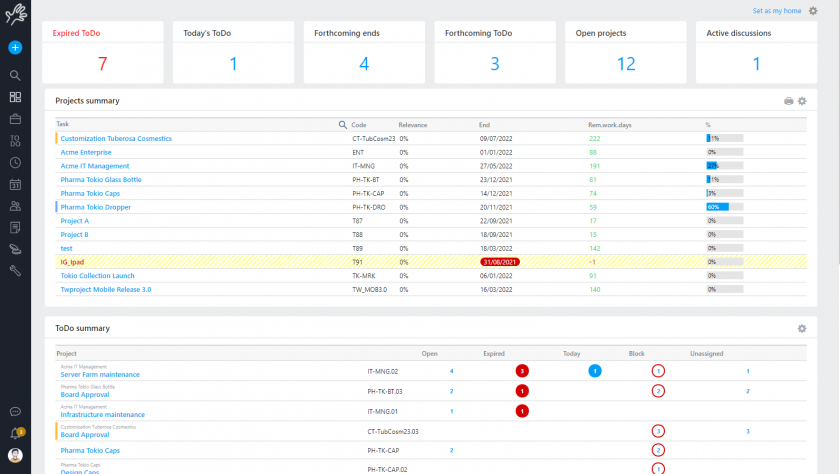Managers must recognize and respond to all the corporate environmental factors that can influence their organizations, taking into consideration the risks and opportunities that arise.
Navigating through the modern chaotic work environments is like trying to drive a small boat to shore during a hurricane.
CONTENT INDEX
Corporate environmental factors: the internal environment
- Corporate internal environment: the Staff
- Corporate internal environment: the budget
- Corporate internal environment: Corporate Culture
Corporate environmental factors: the external environment
- Corporate external environment: the Economy
- Corporate external environment: the competitors
- Corporate external environment: Politics
- Corporate external environment: Customers and Suppliers
Dealing with corporate environmental factors: the software that can help you
Just like this small boat, the modern organizations and their managers are faced with a significant amount of factors that require immediate response.
The forces that drive this change in the business are known as internal and external environmental factors.
In this context, corporate social responsibility and the need to achieve goals are paramount.
Corporate environmental factors: the internal environment
The internal environment of an organization refers to events, factors, people, systems, structures and conditions inside an organization that are generally under the direct control of the company.
Corporate mission, corporate culture, and leadership style are factors that are typically associated with an organization’s internal environment.
As such, it is the internal environment that will influence the organizational activities, decisions, behaviors and attitudes of employees.
Changes in leadership style, in the corporate mission or in culture can have an important impact on the organization.
Let’s see in detail what are the internal corporate environmental factors.
Corporate internal environment: the Staff
Employees are an important part of the internal environment of an organization.
Managers must be able to manage lower-level employees and, at the same time, supervise the other factors that affect dynamics among the team.
Effective staff management requires managers to develop leadership, communication and motivation skills in order to create a productive and harmonious working environment.
This involves the ability to coordinate and supervise employees, ensuring that all team members understand their roles and contribute to the company’s objectives. This process includes the selection, training, career development and performance evaluation of employees.
The HR management process consists of several key stages:
- Selection: Identifying and recruiting the best available talent.
- Training: Providing continuous learning opportunities to improve skills and keep staff up-to-date.
- Career Development: Planning professional development paths that motivate employees and help them reach their full potential.
- Performance Evaluation: Monitoring and evaluating employee performance to recognise achievements and identify areas for improvement.
Continuous training and professional development are essential to keep staff up-to-date and motivated.
Companies that invest in the development of their staff’s competencies achieve a twofold benefit: they improve the quality of work performed and increase employee satisfaction and loyalty.
In contrast, internal politics and conflicts may arise due to various factors, such as personality differences, personal ambitions, limited resources and misaligned expectations.
It is up to management to prevent and mitigate such situations through clear communication, the implementation of fair and transparent policies and procedures, and the promotion of a positive company culture.
Indeed, even when everyone is capable and talented, politics and internal conflicts can destroy a good organisation from within.

Corporate internal environment: the Budget
In business, even the lack of money can determine the survival – or not – of a company.
When cash resources are too limited, that can affect the number of people you can hire, the quality of equipment and the type and amount of advertising you can buy.
If you have enough money instead, you have much more flexibility to grow and expand the business, or to endure an economic downturn.
Corporate internal environment: Corporate Culture
The internal corporate culture consists of the values, attitudes and priorities that employees live every day.
A ruthless culture in which every employee competes with his colleagues certainly creates a different, and more toxic, environment than that of a company that emphasizes collaboration and teamwork.
Corate environmental factors: the external environment
The external environment is composed by factors that occur outside the organization but which can cause internal changes and are, for the most part, beyond the company’s control.
Customers, competition, economy, technology, political and social conditions, and resources are common external factors that influence the organization.
Even if the external environment occurs outside an organization, it can have a significant influence on its current operations, growth and long-term sustainability.
Ignoring external forces can be a damaging mistake for managers. As such, it is necessary that managers continue to monitor and adapt to the external environment.
The key is to work in order to make proactive changes rather than having to take a reactive approach and solve problems rather than preventing them.
Companies must consider the environmental impacts of their operations and promote positive change in both social and natural environments. Adopting strategies to mitigate climate change and pursuing sustainable development goals can be decisive steps to reduce the negative impact of their activities.
So, let’s see in detail what are the external corporate environmental factors.
Corporate external environment: the Economy
In a bad economy, even a well managed organization may not be able to survive.
If customers lose their jobs or take jobs that can barely support them, they will spend less on sport activities, recreation, gifts, luxury goods, and new cars.
It is not possible to control the economy, but understanding it can help identify threats and opportunities.
Companies must consider the risks and opportunities arising from economic changes and adapt their operations accordingly.
Corporate external environment: the Competitors
Unless the organization is a monopoly, you will always have to deal with the competition.
When you open a company, you normally find yourself fighting against established and more experienced organizations in the same sector.
On the other hand, when a company has established itself, it will find itself fighting against new organizations trying to steal a slice of the market.
In short, competition never dies.
Corporate external environment: Politics
Changes in government policy can have a huge impact on an activity.
A classic example is the tobacco industry.
Since the 1950s, cigarette manufacturers have been asked to put warning labels on their products and have lost the right to advertise on television. Smokers have less and less places where they are allowed to smoke. Therefore, the percentage of people who smoke is diminished, with a corresponding effect on the sector’s revenues.
Corporate external environment: Customers and Suppliers
Next to employees, customers and suppliers are, in most cases, the most important people with which an organization has to deal.
Suppliers have a huge impact on costs. The weight of a given supplier depends on the scarcity of their service or product and, consequently, on the possibility of negotiation.
The power of customers depends on the fact that they are free to choose between a specific organization and its competition.
With Twproject we simplified client project management and budget control


Dealing with corporate environmental factors: the software that can help you
Undoubtedly, It will be more difficult to influence the more general factors external to the organization. In any case, the project manager has to be conscious of external issues and ready to act accordingly.
Moreover, the project manager is also responsible for communicating and informing the team of factors influencing a project, both internal as well as external.
On the other hand, it is much easier to manage internal factors.
In project management, you can influence those factors that are closer and more directly related to management, such as resources or project management systems.
With the help of a project management software like Twproject you can have control on your resource load, on your project progress with complete statistics so that you can take immediate action to those internal factors that are visible at one click and signaled with an alert.

The Supervisor page in Twproject allows you to view an exhaustive summary of open tasks that are almost completed or should be.
The system will mark in red the deadlines and delays, the possible presence of “blocking” ToDos, and you will therefore be able to understand at a glance which projects are in a critical state.

Also here, you will be able to observe the performance of your team members, in the form of a linear graph, which will allow you to face personnel issues more easily.
Twproject helps organizations in knowing which of the internal factors represent limiting conditions and which are the drivers of the projects for their correct management.
You can do a free trial and if you have any questions on the subject, you can count on our support team!




